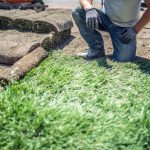
Prepare Your Lawn For Spring
As we move into warmer weather and the snow and ice begins to melt away, we start to see our lawn peeking out at us once again. Sometimes the grass looks healthy and green, and other times, well…not so much.
Understanding the best ways to wake up your lawn from our long, and particularly severe winter, is important to ensure that you have a healthy, strong, green lawn that you can enjoy all summer long.
Here are some of the best ways to help you prepare your lawn for spring:
Aerate Your Lawn
It’s really important to properly aerate your lawn following the winter season. The weight of the snow and ice (and maybe the occasional snowman) can put a lot of pressure on the grass and compact the soil.
Compacted soil prevents water, nutrients, and oxygen from reaching the roots of your turf. If these elements are not allowed to enter the layers of soil, then your grass will dry out, the root structure will stop developing, and your lawn will eventually die.
Expert Tip: The preferred method of aeration is to use a machine that will remove plugs of soil from your lawn. Removing 2-3 inches of soil will work much more effectively than a spike aerator, which simply pierces the soil.
Spring is the start of the growing season, and an ideal time to aerate and give your lawn the best chances of growing strong.
Regular Watering
To encourage growth, you want to make sure that your lawn is getting watered regularly. If the spring is particularly rainy, then you may not need to supplement with extra watering.
However, you do want to make sure that the roots are kept moist, to help your lawn get off to a good start. A strong start to the growing season will help your lawn thicken and prevent weeds from taking hold.
Fertilize Your Grass
Using a special turf fertilizer made by a reputable manufacturer will help you add nitrogen, phosphorous, and potassium into your soil.
The amount of fertilizer required will vary depending on your soil, type of turfgrass, and how much you want your grass to grow.
Expert Tip: Ensure that you apply water to the grass after fertilizing to avoid any potential burning.
We recommend consulting a professional in order to ensure that you are applying the right products for your location.
Overseed Your Lawn & Dead Spots
The winter can be hard on your lawn, so early spring is an ideal time to overseed. Overseeding is a great way to fill gaps in your lawn, thicken existing patches, and fill in any bare spots.
Once all the debris has been removed from your lawn, rake the existing lawn to loosen the top layer of soil and remove any dead grass. If you notice any thatch (a layer of dead grass shoots, stems, and roots) be sure to remove that. Then, apply new seed — this can be done manually or with a seed applicator.
If you are looking to fix a larger area, using farm fresh turfgrass sod is your best solution. Turfgrass sod is an established product and the tight root structure will keep out weeds. Click here to use our handy sod calculator and determine exactly how much turfgrass sod you will require. For resources on how to prepare, install, and maintain turfgrass sod click here.
Once you have your sod calculation ready, click here to find your local sod producer.
Stay connected with the NSGA for the support and resources you require.
 BOARD OF DIRECTORS LOGIN
BOARD OF DIRECTORS LOGIN


